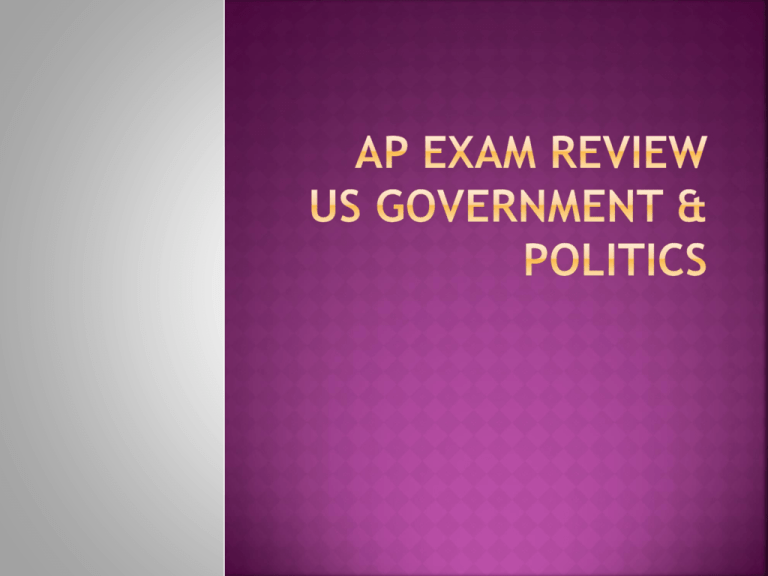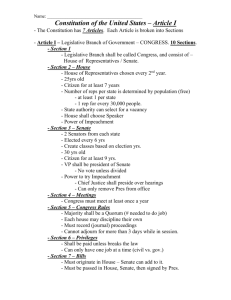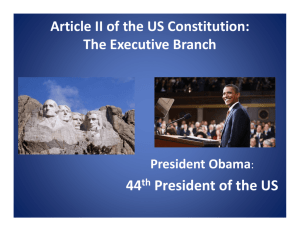AP Exam Review US Government & Politics
advertisement

Declaration of Independence – 1776 Unalienable/natural rights Government is limited by the consent of the governed Colonists were separating from Great Britain Jefferson and others borrowed ideas from Locke’s 2nd Treatise of Civil Government Articles of Confederation Weak national government with one-house Congress where states had most power Problems: no unity among states, no power to tax, differing currencies, no chief executive or national court system, lack of foreign policy and security Constitution The Great Compromise or Connecticut Compromise – Philadelphia 1789 Congress would be bicameral – Senate has equal representation for smaller states (NJ Plan) and House has proportional representation for larger states (VA Plan) 3/5th Compromise – every five slaves would count as three for representation and tax purposes Federalists (rich elite) supported the new Constitution in the Federalist Papers but AntiFederalists (farmers and middle class) wanted a bill of rights to protect individuals – these were the 1st political parties Article I – Legislative Powers – enumerated powers - taxes, regulate interstate commerce, make laws, coin money, declare war Elastic or “necessary and proper” clause – allows Congressional power to be interpreted broadly – creates implied powers DENIED Powers Denying habeas corpus – detaining without trial Bill of attainder – proscribes penalties w/out due process Ex post facto – laws that declare something illegal after the fact Article II – Executive Powers – commander-in-chief, makes treaties, appoints officials, signs or vetoes legislation, State of the Union, can call special sessions of Congress (these are called formal or delegated powers) Electoral College – 12th Amendment (1804) required separate votes for President and VP to prevent outcomes like in 1796 and 1800 Article III – Judicial Powers – very vague – Only one Supreme Court – no specific qualifications – judges not held responsible to voters – power comes from judicial review which was established by precedent in Marbury v. Madison 1803 Article IV – States’ rights – “full faith and credit” clause says that states must respect other states’ laws and judgments Article V – Amendment process – proposal by 2/3 of Congress and ratification by ¾ of state legislatures Article VI – Supremacy Clause – Constitution always overrides state laws Article VII – Ratification – nine states had to sign 27 amendments Republicanism – power comes from the people in the form of elected representatives Federalism – power is divided between the central (federal) and state governments Dual federalism (layer cake) – separate and distinct roles – focuses on 10th amendment Cooperative federalism (marble cake) – shared responsibilities Separation of Powers – three branches have distinct functions Checks and Balances – each branch has some control over other branches Federalist Papers #10 – James Madison said factions (interest groups) can be dangerous and must be controlled – diversity is good and “tyranny of the majority” must be prevented to protect minorities #51 – Madison supports the idea of checks and balances and federalism saying this will further protect from tyranny #84 – Alexander Hamilton argues the Bill of Rights was dangerous because every single right could never be predicted and therefore government might have free reign on unspecified rights Grants-in-aid - $ given to another level of government Categorical Grants – targeted for a specific purpose (gives federal government more power) Formula Grants - $ distributed based on eligibility requirements (Head Start for example) Project Grants - $ distributed based on competitive application process Block Grants – to be used for general purposes such as education (gives state government more power) Preemption – Congress enacts a law for the federal gov’t. to take responsibility for a state function (Food Labeling in 1990) Mandate – federal gov’t. forces states to comply with minimum standards – the problem is they are often unfunded mandates that place a burden on states “New Federalism” was a hallmark of the Nixon and Reagan administrations Religion Establishment clause – government cannot promote religion (Lemon Test 1971) Free-exercise clause – government cannot inhibit religion (strict scrutiny) Speech and Press Prior restraint – censorship before publication Clear and present danger – speech cannot incite violence (Justice Holmes – Schenck v. US 1919) NY Times v. Sullivan 1964 – libel is not protected TX v. Johnson 1988 – flag burning is protected as symbolic speech Selective Incorporation – Court has used the 14th amendment to apply the Bill of Rights to the states Due process, double jeopardy, Miranda warnings, exclusionary rule, good-faith exception 9th Amendment – not all rights have been listed in the Constitution Privacy, birth control, homosexuality, abortion Equality of opportunity vs. equality of outcome Amendments 13, 14, & 15 ended slavery but the black codes, grandfather clauses, poll taxes, Jim Crow laws, and Plessy v. Ferguson 1896 weakened blacks’ rights NAACP used courts to end segregation in Brown v. BOE 1954 De jure – imposed by government De facto – occurs naturally MLK Jr and civil rights activists used boycotts and civil disobedience lead JFK and LBJ to pass the Civil Rights Act of 1964, 24th amendment, Equal Opportunity Act of 1964, Voting Rights Act of 1965 and the Fair Housing Act of 1968 1990 Americans with Disabilities Act Affirmative Action – reverse discrimination or leveling the playing field? Court has been unclear – laws must pass strict scrutiny Compelling governmental interest Narrowly tailored Least restrictive means Bakke – race can be used as one criteria for admissions Public Varies over time, place limits on government action, is not always educated but can spur official to act Sampling should be random, of large size, and have variety to be accurate Distributions Opinion Skewed – leans to one side (death penalty) Bimodal – split (gay marriage) Normal – bell shaped/average (ideology) Socialization – family, school/peers, community Education first, then socioeconomic status are the best indicators of opinion Ideology Liberals – favor economic equality & freedom of choice of behavior Conservative – favor economic choice & social order Participation Conventional – routine and acceptable – voting, writing letters Unconventional – uncommon and defiant – civil disobedience, strikes Reasons for low voter turnout We vote more often and for more offices Obstacle of registration Feeling that gov’t. is not responsive Less identification with political parties Obstacle of researching all options Functions of parties – nominating candidates, structuring the voting choice, proposing alternative programs, coordinating actions of officials Minor/3rd parties Bolter – splits from major party – Progressives 1912 Farmer/labor – represents working class – Populists 1892 Ideology – propose different doctrines and principles – Socialist Single –issue – promote one principle, not an ideology – Prohibition Majority representation ( rather than proportional) favors the two-party system National Organization National convention every 4 years National committee(RNC and DNC) – governs parties between conventions Congressional party conferences – beginning of each session to select party leaders and committee assignments Congressional campaign committees – raise funds to support candidates Responsible Party Model Parties present clear platforms Voters choose candidates based on party platform Winning party carries out its platform Voters hold party responsible at next election for carrying out the platform or not 4 stages of Presidential Campaign “invisible primary” many candidates do fundraising and campaigning Primary season – begins with Iowa caucus and NH primary in early Jan, “Super Tuesday” (Feb) – frontloading Presumed candidacies (Mar) Nominating conventions (Jul/Aug) Most countries nominate candidates, US elects candidates Primary – state election to choose preferred presidential candidate Open – can vote in either party OR Closed – can only vote for the party you are registered as Caucus – meeting of party members to choose candidate General election (Early Nov every other year) Presidential every four years, in between years are Congressional, off-year, or mid-term Electoral College – each state has electors equal to their representatives in Congress – 538 total – 270 required to win Voters are not educated and a direct popular election would make recounts impossible – but it is possible for a candidate to win the electoral college and lose the popular vote (1888 & 2000) Campaigns Open election– no incumbent Incumbent advantage – name recognition, casework, franking privilege, media, financing Financing – 1971 Federal Election Campaign Act Limited hard money contributions to $1000 per individual and $5000 per PAC– critics said their 1st amendment right to free speech was violated but the Supreme Court upheld the law FEC – Federal Election Commission – 6 bipartisan members began enforcing limits and disclosing all campaign spending in 1976 2004 Bipartisan Campaign Reform Act or McCain-Feingold Act – indexed hard money contributions for inflation but limited soft money contributions 527s – tax exempt groups not tied to any candidate but focus on particular issues (MoveOn.org) Purposes – representation, participation/action, education, agendabuilding, program monitoring Group Theories Pluralist – competing groups are good because they offer options and force government to act Hyperpluralist – competing groups are bad because they pull government in different direction and result in gridlock Elitist – competing groups only represent the rich and gives them too much power Resources – membership, lobbyists, money Free rider problem Lobbying Techniques – direct contact with officials, letter writing campaigns, influencing press, testifying at congressional hearings, providing research and feedback to officials, PAC fundraising, using technology to spread information, coalition building Private Ownership=infotainment – news is selected based on audience appeal and sensationalism Federal Communications Commission created in 1934 Functions of Media Reporting the news Interpreting the news – gatekeepers Influencing public opinion Setting the political agenda Socializing citizenry about politics “Fox effect” – more conservative perspective Congress House – 25 yrs old, citizen 7 years, serves 2 year terms – based on population so closer to constituency House – originates revenue bills, chooses president if electoral college cannot, initiates impeachment proceedings Senate – 30 yrs old, citizen 9 years, serves 6 year terms – every state gets 2 but ideally more wise and experienced Senate – approves presidential appointments and treaties and tries impeachments Descriptive representation is goal, but gerrymandering can happen during reapportionment every 10 years Legislative Process Introduction and assigned to committee Subcommittee studies, holds hearings, debates Original committee considers bill, if approved (Rules Committee in House only) Full House or Senate – if two different bills, they must be reconciled in Conference Committee Back to full House or Senate President can sign or veto Congress can override veto by 2/3 of each chamber Oversight – making sure agencies are carrying out laws – done by investigations, hearings (Katrina & FEMA), requests reports Speaker of the House – leader from majority party (Pelosi) Senate – VP is technical leader (Biden), president pro tempore is honorary position given to most senior member (Byrd), real power is majority leader (Reid) Senate can filibuster – talk a bill to death but since 1917 60 members can vote to invoke cloture – to stop a filibuster/limit debate Trustee – follow one’s own ideas OR Delegate – represent constituents Earmarks/Pork-barrel spending result of negotiations and a cause of national deficit 35 yrs old, natural born citizen, resident for 14 years, serves 4 year terms Formal powers from Constitution, inherent powers, executive orders, delegation of powers from Congress (FDR during Depression) White House Office/Executive Office (NSC, OMB, Economic Advisors, VP) – closest to President Cabinet – department secretaries – too large, limited expertise, appointed for diversity or reputation – therefore not as close to President Character Power to Persuade Honeymoon period Line of Succession – VP, House, Senate, Cabinet Secretaries Divided Government – one party control presidency & other control Congress – can result in gridlock Line-Item Veto – power to only reject parts of a bill – President does not currently have but McCain and Feingold are pushing for to limit earmarks War Powers Act – 1973 – Congress overrode Nixon’s veto to limit presidential commitment of troops without a declaration of war 15 departments Independent agencies (NASA) Regulatory agencies (FDA, EPA) Government corporations (TVA, Post Office) Civil Service – hired based on merit rather than patronage – Pendleton Act passed in 1883 after President Garfield assassinated Congress gives agencies administrative discretion – latitude to make policy because Congress does not have time or expertise and does not want the blame America wants more services but smaller government Reforms Deregulation Competition and outsourcing Performance standards Supreme Court - 9 justices appointed by President, approved by Senate, serve life terms – power of judicial review Activism – loosely interpret existing laws and use their own values (Warren 53-69) Restraint – adhere closely to existing laws Cases start in either US District Court or State Trial Courts, then go to Courts of Appeals, then finally to the Supreme Court Criminal vs. Civil Precedent and stare decisis (let the decision stand) Solicitor General – lawyer that represents US government Amicus curiae brief – (friend of the court) information given to the court by an interested party who is not actually part of the trial Decision Making 150,000 cases from state and federal courts – raise a federal question 8,000 requests for review – writ of certiorari (asking the court to review previous decision) Discuss list in conference (99% denied) must pass rule of four 85 cases make it to the docket Attorneys submit written briefs (arguments) Hear oral arguments Conference – ends in vote or judgment Opinion assigned Unanimous – all agree for same reasons Concurrence – agree but for different reasons Dissent – disagree with majority decision Economic Laissez-faire – no government interference Keynesian – gov’t. adjusts fiscal policy (taxing and spending) and monetary policy to combat inflation and depression Monetarism – Keynesian is too slow and ineffective – focus on monetary policy only (controlling money supply) Supply Side – government should lower taxes to create more jobs and leave more money for people to invest so benefit will “trickle down” to everyone – basis of Reaganomics Recent budget reforms (Bush’s BEA and Clinton’s BBA) produced surpluses in 98-01 but Congress allowed caps on discretionary spending to expire in 2002 US pays less in taxes than most other countries Most federal spending – Social Security, Defense, Medicare Progressive tax (income tax) vs. flat tax (sales tax) Welfare State developed after Great Depression – FDR’s New Deal and LBJ’s Great Society programs Entitlements cannot be denied to those who are eligible Monroe Doctrine 1823 – isolationism and noninterventionism WWII lead to containment of Communism and Cold War – NATO, Marshall Plan, and nuclear weapons Nixon focused on detente Carter – human rights Bush – War on Terrorism – preemptive action Today – move to global policy of cooperation Investment, trade, human rights, poverty, foreign aid, environment Policy Makers State Department, Dept. of Defense, NSC, Intelligence Community (16 agencies)








